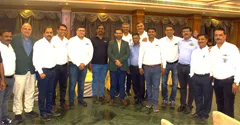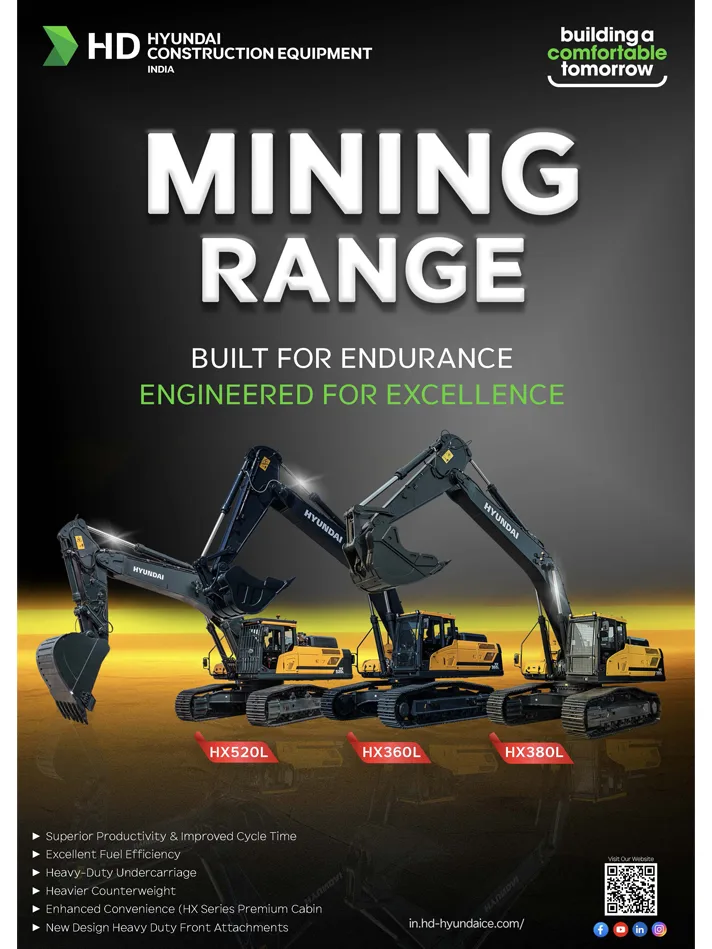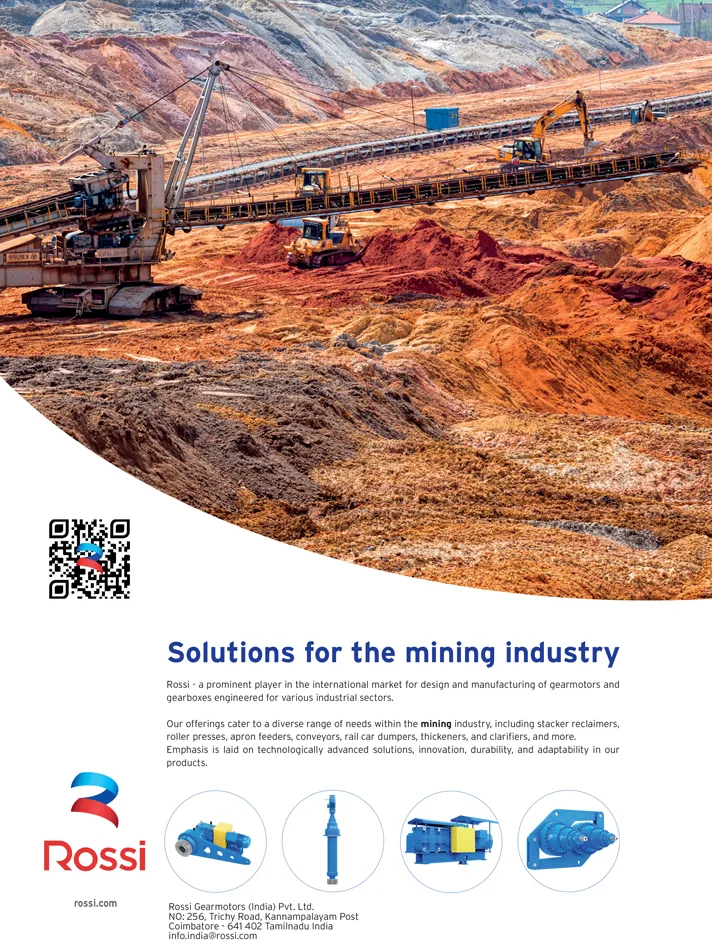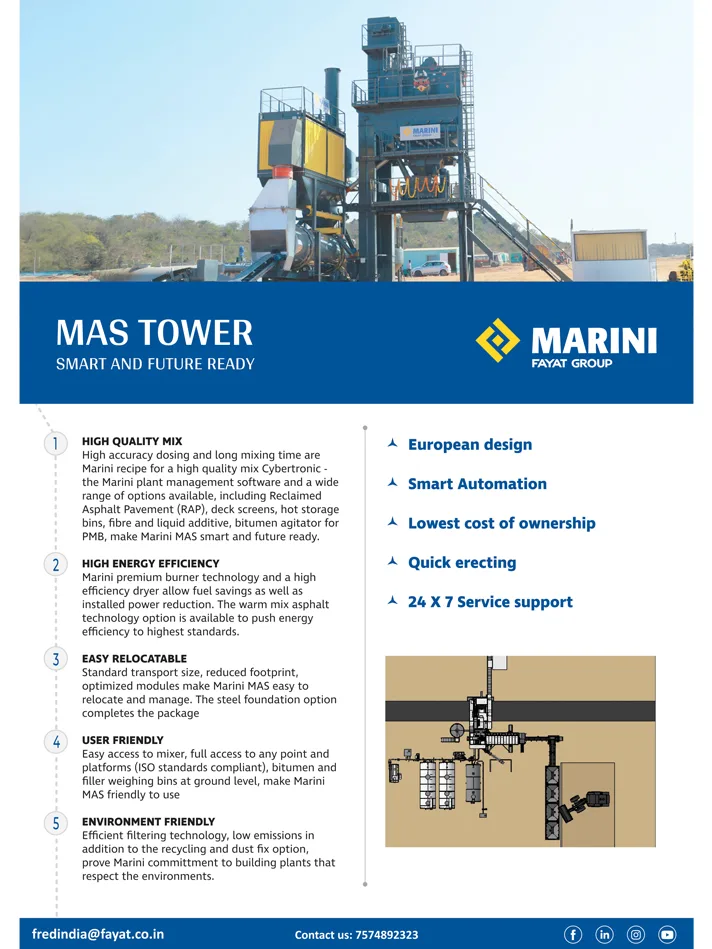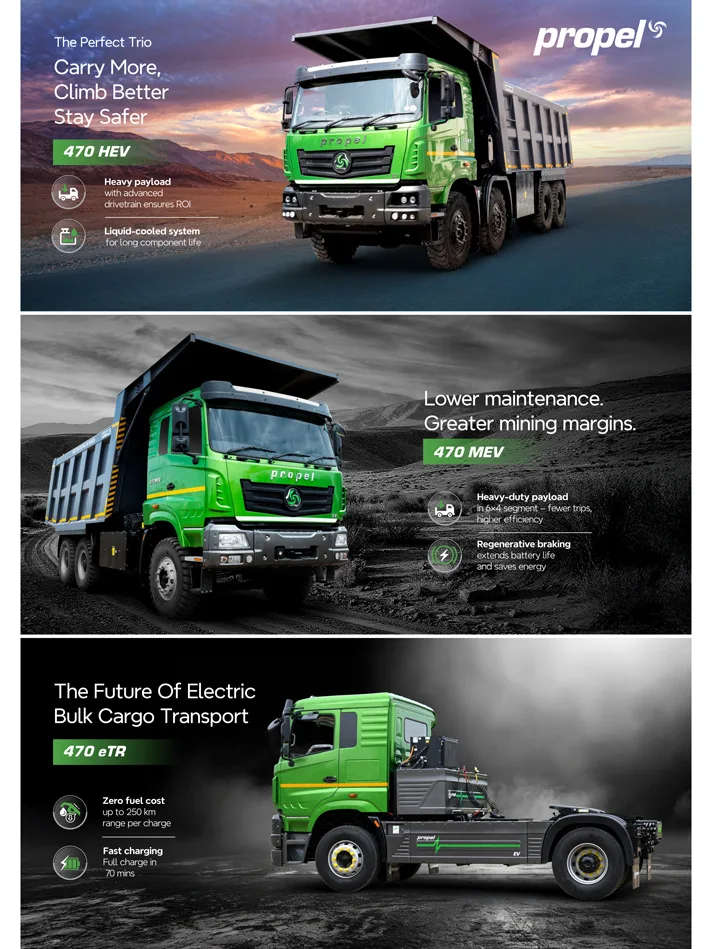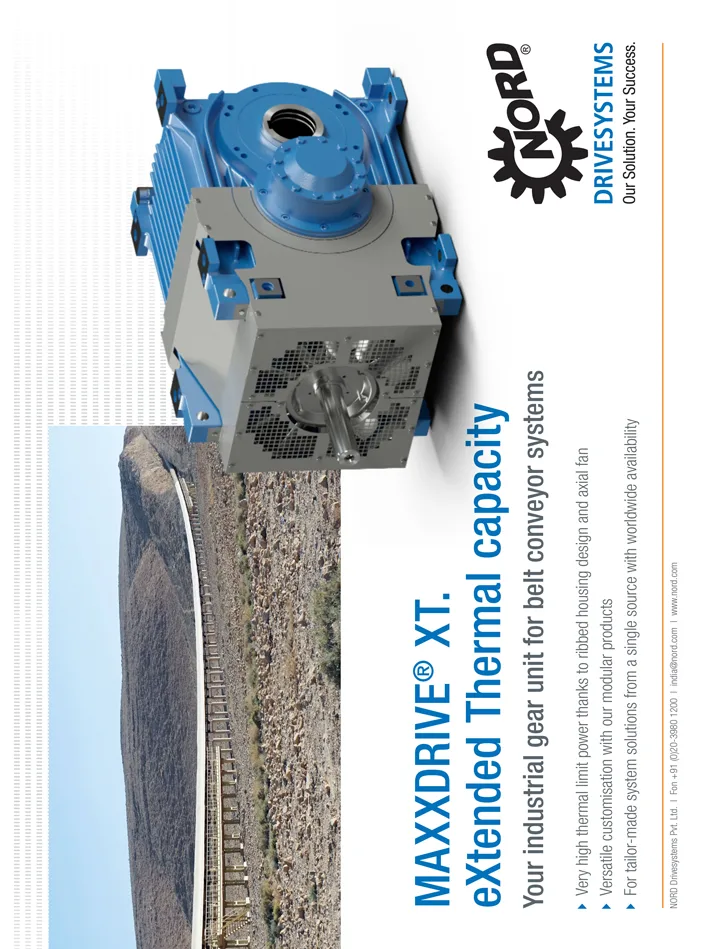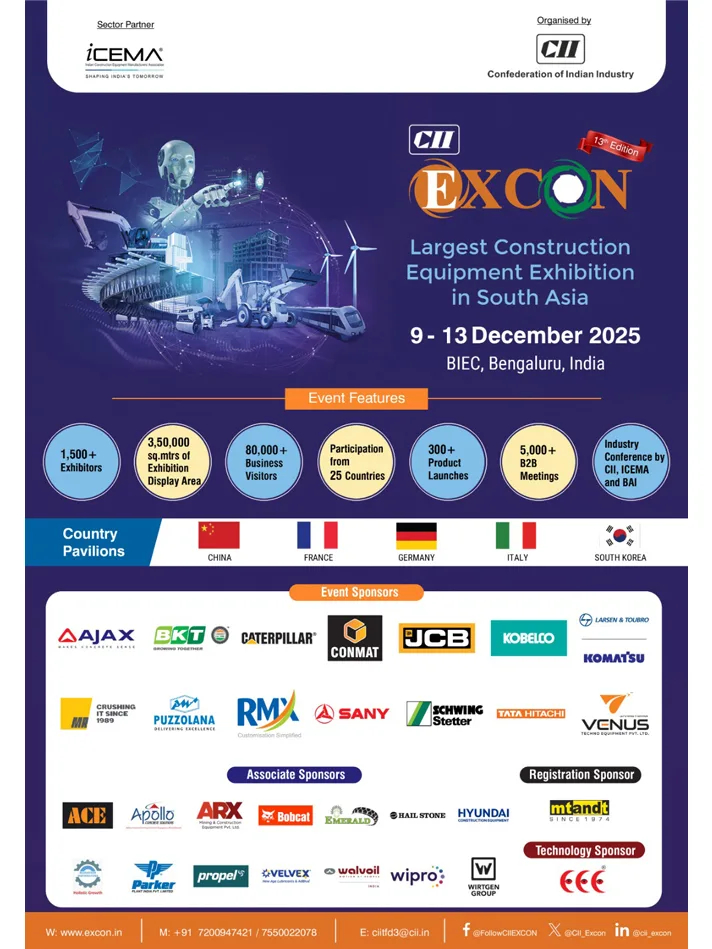
GenX Construction Equipment – Showcasing the Dual Power of Being SMART & SUSTAINABLE
The construction equipment industry is at the cusp of a significant transformation while setting new trends on the back of GenX technologies that are set to revolutionize how we build. These advancements enhance construction site safety, efficiency, and sustainability from alternative power solutions to autonomous machinery. Our Cover Story this time highlights the shaping up trends in the construction equipment space and showcasing how leading equipment manufacturers are leading the way by offering Smart & Intelligent Construction Equipment and are setting the tone of development globally with Smart & Sustainability being the key themes for the future….. writes, PRERNA SHARMA.
Rapid technological upgrades, including telematics, GPS tracking, and automation, are revolutionizing the construction equipment market, according to recent research by Global Market Insights. These innovations improve equipment performance, enhance safety features, and increase operational efficiency. Contractors and construction companies are increasingly adopting technologically advanced machinery to optimize project timelines, reduce costs, and minimize downtime. As a result, there is a growing demand for modern construction equipment equipped with cutting-edge technology.
Ever-advancing technology and green energy are the consistent focal points for advancement. Large machines are becoming safer, more accurate, and more environmentally friendly, as the industry now looks to prioritizing autonomy as it meets the demands of this modern world.
New data from Komatsu Smart Construction has indicated the adoption of digital tools across the construction sector is increasing. The brand, from Komatsu, aims to deliver technology that helps reduce costs and time on construction sites by deploying mixed software and hardware solutions across earthmoving and construction. The engagement in equipment such as 3D Machine Guidance has doubled since the launch in 2023. Other solutions that have seen annual growth include Dashboard, a data collection tool that combines the 3D design data with aerial mapping and intelligent machine data to create a digital twin that allows stakeholders to gain instant access to critical data.
The global trend for all vehicles is continued progress toward becoming carbon neutral. The automotive industry has been transformed with this goal in mind, and 2024 is finding that construction machinery is making huge strides in this area as well. These electric machines offer fuel savings (the cost of diesel fuel remaining the foremost expense for the operator) and reduced toxic emissions in the environment. Unfortunately, charging time of electric equipment has been a challenge to the construction industry, where every hour counts toward (or against) getting the job done on time. Again, technology is the hero in this story. It is evolving to lessen charging time for these massive vehicles, so operators are finding that they can cut charging hours while prioritizing the health of our environment.
For those machines that currently continue to demand diesel fuel, manufacturers are exploring technology that will at least lower the emission of that fuel. This is resulting in longer operation with less harm to the environment. In addition to using advanced technology toward energy savings, manufactures are making safety a priority. Heavy machines are being equipped with object detection proximity sensors and blind spot monitors, which emit a loud sound when objects are near that the operator might not be able to see.
In addition, camera systems are being added to machines that not only increase rear view but all-around view as well (AVMs). These AVMs are dramatically increasing an operator’s perspective of the job site. He or she no longer spends valuable job time checking the site manually. These cameras afford 270 degrees of visibility, substantially decreasing the risk of accidents and injuries.
Progress in creating autonomy in the construction equipment industry is perhaps the most significant trend as we progress, as it encompasses all the goals of the industry. Manufacturers are investing in technology that allows equipment to be monitored and controlled remotely. Some are currently testing excavators and wheel loaders that can even effectively perform without an operator in the cab.
Setting the Trend:
The compaction equipment industry in India is witnessing robust growth, driven by substantial investments in infrastructure, urban development projects, and road construction. As the third-largest construction equipment market globally, India’s demand for compaction equipment continues to rise. Technological advancements are also shaping the market, with companies integrating smart diagnostics for enhanced monitoring and efficiency. Currently, the market size is estimated at around 5000 machines in 2023, with an overall increase in sales of 35% compared to 2022. Q1 of 2024 has shown similar market size compared to 2023 and we are expecting the market to grow by 8% on YoY basis.

According to Dimitrov Krishnan, MD,.Volvo CE India, “Volvo CE integrates cutting-edge technologies in its compaction range to ensure optimal performance and operational efficiency. Our products feature advanced hydraulics for precise control and fuel efficiency, which contribute to lower operating costs and reduced environmental impact. Safety is paramount, with Volvo CE’s equipment incorporating robust safety features such as reinforced, industry best and extremely safe canopies and ergonomic controls for operator comfort and protection. These innovations distinguish Volvo CE from competitors by offering superior reliability, productivity, and sustainability.”

Talking about the advances in the compaction equipment, Satendra Tiwari, Executive Director – Operations, Case Construction Equipment, highlights, “The compaction equipment sector is essential in shaping these infrastructure landscapes, leading to increased road and highway construction across various regions. Additionally, the National Infrastructure Pipeline (NIP) is set to expedite the development and modernization of road and highway networks. With transportation as a critical priority, the NIP has allocated a substantial $1.4 trillion for infrastructure investments by 2025.”
The CASE 952EX Soil Compactor and 1107EX PD Soil Compactor, employs a vibratory compaction method. This technique uses eccentric weights rotating at high speeds to create vibrations in the compactor’s drum. These vibrations are transmitted to the soil or asphalt surface, causing effective densification and compaction. The vibrating drum generates both vertical and horizontal forces, working together to achieve optimal compaction. The vertical force compresses soil particles, reducing voids and increasing material density, while the horizontal force levels the surface and ensures even compaction. Using vibratory compaction, our equipment can achieve greater compaction depths and superior results compared to static compactors.
VÖGELE also offers an innovative and economical solution for the road construction sector with the non-contacting Road Scan temperature measurement system. The scanning and documentation of the freshly paved asphalt‘s temperature is already specified in tenders in several markets, and in others there are definitive plans to implement this.
Hamm Compactors are equipped with isolated operator platform mounted on shock absorbers so that the vibrations are reduced. The operator platform is with Antiskid material to ensure operator safety. The sliding seat console for operators and excellent drum edge visibility are some striking features which make the machines easier to operate. Hamm soil Compactors are built with patented design of three point articulation joint. This connects the front and rear end of the compactor and enables excellent directional stability and provides driver safety on difficult terrains and also adds to drivers comfort. This also increases the operator efficiency. WIRTGEN GROUP has always served its customers with technology intensive machines including the Hamm soil compactors and tandem rollers. We are already offering ICT based technologies and features in our compactors.
Ammann incorporates intelligent machine features, telematics, and IoT technology into its equipment to enhance performance, efficiency, and maintenance. What distinguishes the equipment from competitors would depend on the specific features and innovations implemented.
At the heart of SCHWING Stetter India’s batching plants lies their advanced control systems, which set the industry standard for accuracy and consistency. These systems are based on cutting-edge PLC (Programmable Logic Controller) technology, enabling seamless automation and integration of key functions. From precise weighing to efficient mixing, conveying, and discharging, the control systems ensure each step of the concrete production process is meticulously executed.
Moreover, the control systems provide real-time data and feedback, empowering operators with valuable insights into the production process. With remote monitoring and troubleshooting capabilities, SCHWING Stetter India’s control systems offer unparalleled convenience and efficiency. Operators can remotely oversee operations, diagnose potential issues, and optimize performance, ensuring minimal downtime and maximum productivity. SCHWING Stetter India’s dedication to delivering superior quality concrete is evident in every aspect of their batching plants. The company employs stringent quality control measures throughout the manufacturing process, ensuring that each plant meets the highest industry standards. From the selection of premium-grade materials to the rigorous testing of components, SCHWING Stetter India leaves no stone unturned when it comes to quality assurance. In addition, the use of state-of-the-art control systems plays a pivotal role in guaranteeing consistent quality. By closely monitoring and controlling variables such as material proportions, mixing time, and environmental conditions, SCHWING Stetter India’s batching plants ensure the production of concrete that adheres to precise specifications. This unwavering commitment to quality gives construction professionals the confidence they need to tackle even the most demanding projects with assurance.
On the changing technology landscape in construction equipment market, Williams RJ, MD, Hailstone Innovations, informs, “We are known for incorporating latest technology to constantly upgrade our products, which in turn benefits our customers. Our SMART machines are winning appreciation all over. The automation features in our machines makes life easier for stakeholders. We stand out among the crowd because of our product quality, latest technology, ease of operation, best-in-class safety and maintenance features.


According to Marcel Kerkhofs (MK), Global Marketing Manager, Keestrack N.V. & Deepak Pandit (DP), Country Manager – Sales & Marketing, Etrack Crushers Pvt Ltd (A Keestrack Group Company), “At Keestrack, we recognize the importance of reducing greenhouse gas emissions and transitioning towards a greener future. This is the main reason we innovate our equipment as much as we do because Keestrack, the internationally renowned manufacturer of mobile crushing and screening equipment, intends to be at the forefront of the construction industry’s drive toward a zero-emissions future and a circular economy. The construction industry is responsible for 6-10% of the world’s greenhouse gases and Keestrack wants to create change in the industry.”
Recently Keestrack introduced the ZERO-drive machines, without any combustion engines on board. Electric motors drive most of the mobile crushing and screening equipment and power some necessary hydraulics systems. The following equipment is available in ZERO-drive: all cone crushers, all impact crushers incl. I4e, all scalper screens except the K8, C6e classifier, all stackers, all jaw crushers except the B3 and the tracked Apron feeder A6.
Keestrack will keep looking into other drive systems like hydrogen, fuel cells, battery packs and will be at the forefront of new innovations. The external drop-off engine/gen set unit, on the complete right, powering up the primary and secondary production line of two No.’s B7e Zero drive machines.

Takemichi Hirakawa, Managing Director, Kobelco Construction Equipment India Pvt Ltd., recently unveiled the SK80 Excavator that boasts of several innovative features like superior technology, advanced hydraulic system, fuel efficiency, operator comfort, durability, maintenance and versatility which set it apart from its competitors and underlines its commitment to sustainability. Coming with a range of attachments, the SK80 Excavator can be easily adapted to perform a variety of tasks – be it digging, lifting or grading.
Equipped with Yanmar Engine which reflects Japanese technology, the excavator aims to provide best-in-class performance. The eco-friendly engine reduces fuel consumption and emissions, lowers operational costs and minimizes environmental impact. The state-of-the-art hydraulic system ensures smooth and precise operation. This system enhances the machine’s digging and lifting capabilities, making it ideal for a variety of applications. The SK80 excavator has been designed with a spacious and ergonomic cabin with adjustable seating, touchscreen colour monitor and intuitive controls that ensure operators’ wellbeing and comfort. The robust built of the machine make it the preferred choice when working conditions are the toughest. The SK80 Excavator requires minimal maintenance, ensures maximum uptime and productivity.
JCB recently exhibited the NXT 225LC M tracked excavator with a mechanical fuel injection system. It comes fitted with a power boost feature, a heavy-duty bucket and eco-hydraulics along with ‘Intellicontrol’ and has 10 different power modes giving 5% higher fuel efficiency & 5% output. Also introduced was the new NXT210LC Tunnel Master, a solution designed for tunnelling applications. The dig end has been designed and adapted to work in a tunnelling environment in confined spaces. The Tunnel Master machine augments the application-related solutions to the customers, enabling India’s infrastructure development. Another model, NXT 205, which has 8% improved fuel efficiency, is integrated with eco-hydraulics and ‘Intellicontrol’, and has 10 power modes offering high fuel efficiency and productivity.
In the smaller range of compact mini excavators, the JCB 18Z, along with the JCB 19C-1E electric mini excavator, were recently launched on the sidelines of an event. The 19C is a Zero-Emission machine and has four Lithium-ion batteries that power the machine for a full day on a single charge. With a significant focus on safety and productivity, JCB’s 2GO system safely isolates all controls as a secondary safety system. Its auto-idle and auto kick-up redistribute power to preserve battery life. The 18Z is designed to work in tight spaces in urban as well as rural applications. Available with a retractable undercarriage feature, the 18Z can enter areas with a 1.0m width, making it easy to work in confined areas.
In the material handling segment, JCB India launched the 540-180 HiViz, an 18m reach telescopic handler. It is powered by a 55 kW JCB ecoMax 444 engine without the need for engine after-treatment and has a maximum lift capacity of up to 4 Tons. It has a precise high-speed double boom chain extension system to maximise job site efficiency and a Q-fit mechanism to quickly change 30+ attachments, making the machine multipurpose. The machine comes with an airconditioned, 360° high-visibility global design cabin with ROPS and FOPS.
JCB also recently showcased two-wheeled loading shovels, the first being the 437-4, which comes with a JCB ecoMax 448 engine and an automatic ZF Transmission. It has an improved fuel efficiency of up to 10% as compared to the previous model; with extended service intervals, this machine is also lower on maintenance cost. The 455-4 has a Cummins engine and ZF Axles and transmission. With an increased output of up to 5% in Power mode and a fuel efficiency improvement of up to 10%, as compared to the previous model.
Tracking Global Trends:
Case Construction Equipment (CE) announced the commercial release of its electric 580EV backhoe loader, which the CNH Industrial subsidiary said is the ‘first’ of its kind. The 580EV is powered by a 400-volt, 71-kWh lithium-ion battery platform that’s charged with the same type of Level 2 J1772 adapter found in automotive electric vehicles (EV). The battery platform is designed to deliver up to eight hours of operational runtime on a single charge, depending on the application. It carries over the same dimensional loading and digging specifications and delivers the same breakout forces as Case’s four-wheel-drive, 97-hp 580SN diesel model.
The 580EV also includes an advanced thermal management system with system-specific cooling circuits, which the OEM said helps to better regulate temperatures and maintain performance in hot or cold conditions. “Designing this machine from day one as a purpose-built EV instead of a retrofit has enabled a slew of practical innovations that will positively change the mindset for teams considering EV equipment,” said Brad Stemper, product management lead in North America for Case CE.
The four-wheel-drive electric backhoe uses two independent electric motors for the PowerDrive transmission and hydraulic pumps feeding the loader, backhoe and steering systems to minimize energy consumption and improve performance in loading applications.
Caterpillar’s online platform, VisionLink Productivity, has been improved with the addition of three new features: Cat Grade and Compact, Operator Coaching, and E-Ticketing. The platform is designed to provide managers with insights into job site productivity and equipment utilisation. It collects and summarises data from subscribed machines equipped with a Cat Product Link device.
This is said to allow fleets with mixed OEM equipment to be incorporated into one platform. Caterpillar says that VisionLink Productivity simplifies data management with user-friendly dashboards, including a comprehensive job site summary and detailed insights with key performance indicators (KPIs). The platform analyzes standard telematics data such as machine location, fuel burn, and idle time, providing an overview of machine performance. For more in-depth analysis, advanced data from machines equipped with Cat Payload, Grade, and Compact systems offers job-specific details.
For Dynapac, the key advance is the introduction of its Seismic technology to the asphalt compactor range. This system was first developed for its single drum rollers for use in earthmoving applications. The technology uses sensors that determine the resonant frequency of the material underneath the drum and then adjust the compaction forces accordingly. The benefit of the system is that it ensures more efficient compaction as the dynamic forces are optimized to suit the working conditions. The system ensures that the work is carried out to specification, without risking over-compaction. This reduces fuel consumption as well as the number of passes the machine makes.
Other key benefits of the seismic option include reduced operating noise, less vibration for the machine (in turned reducing wear and tear and fatigue for the operator) and lower fuel consumption. According to the spokesperson, around 10% fuel savings can be achieved through this.
Coming to the market soon from BOMAG will be a novel braking system, which will be available on the ROBOMAG BW 154 asphalt roller (as well as the ROBOMAG BW 177 soil compactor). The Emergency Brake Assist system scans the construction working environment in real time and identifies moving and static obstacles and objects. Objects that could be put at risk by the machine’s movement are detected by the system. If a collision is imminent, the system slows the machine down to a complete stop. By averting potential hazards, the technology marks a significant milestone in enhancing on-site safety.
From Hamm comes a new development in the shape of its HD+ 120i V-VIO-2 HF. This innovative compactor offers the benefits of compaction by vibration and oscillation. While other machines (from Hamm and some competitors) have been able to offer this combination previously, they have been restricted to having one drum for vibration and the other for oscillation. The new HD+ 120i V-VIO-2 however offers both vibration and oscillation on both drums. This allows the operator to combine the compaction types, depending on the application.
Aimed at the rental market, Ammann’s new light tandem roller is petrol-powered and features side-free drums that enable compaction in the tight jobsites. The Ammann ARX 10.1 StV features the Honda GX630 petrol engine rated at 15.5kW. This reduces ownership costs and meets the latest Stage V/EPA Phase III emission regulations. The engine is more compact than the diesel machine, allowing cooling from all sides and helping performance in high ambient temperatures. Petrol is also less expensive than diesel, while there is no need for a diesel particulate filter (DPF) and maintenance of a petrol engine is also less costly than for a diesel engine.
Liebherr has carried out a public demonstration of its new hydrogen fuel technology during a trade event at its factory in Bischofshofen. The world’s first large, wheeled loader to use hydrogen as a fuel was presented to attendees, including representatives from politics and business.
The L 566 H from Liebherr is the world’s first prototype large wheel loader with a hydrogen engine. Following extensive studies, this groundbreaking technology was identified as the optimal solution for operating large vehicles that are difficult to electrify without CO2 emissions. For smaller machines, battery-electric solutions are often suitable. However, the situation is different with larger machines with an operating weight of up to 40tonnes and high energy requirements, internal combustion engines fuelled by hydrogen offer many benefits.
These hydrogen engines are manufactured at the engine plant of Liebherr’s Components product segment in Bulle (Switzerland). They enable zero emissions of greenhouse gases from the tailpipe and almost no nitrogen oxides. They are also highly efficient. Another advantage is that the interfaces are comparable to those of a diesel engine – thermally and mechanically. This represents a significant step forward in the development of sustainable large-scale machinery.
Autonomous Equipment Making a Beeline:
The improved efficiency and productivity of autonomous equipment are fuelling the adoption of autonomous construction equipment. Autonomous equipment can function continuously for lengthy periods of time without needing breaks or becoming fatigued. This results in reduced downtime and allows projects to be finished faster. Autonomous equipment collects real-time data from the workplace using sensors and smart algorithms. This data enables the equipment to improve its performance by selecting the most efficient path, maintaining constant speeds, and reducing material waste. Autonomous equipment can conduct repeated operations with great accuracy and consistency. This lowers mistakes and rework, resulting in a higher-quality finished product and less wasted time and materials.
Autonomous construction equipment is witnessing significant technological advancements. Sensor advancements, such as LiDAR, radar, and high-resolution cameras, enable autonomous equipment to accurately and precisely sense its surroundings. This allows them to better navigate complicated building sites, recognize barriers & risks, and execute accurate operations. The development of faster and more powerful computers, along with advances in Artificial Intelligence (AI), enables autonomous equipment to handle complicated tasks, make real-time choices based on sensor data, and continually learn and improve performance over time. Wireless communication advancements such as 5G allow for smooth data interchange between autonomous equipment, control centers, and other construction machines. This enables greater coordination, remote monitoring, and real-time operational optimization.
Improvements in autonomous technology will impact construction equipment for the foreseeable future. Autonomy can enhance safety by reducing the need for operators on high-risk jobsites. This technology also allows remote monitoring and control, offering real-time insights into equipment performance and enabling quick responses to any issues that may come up. These advanced connectivity solutions revolutionise how construction sites are managed, improving productivity, efficiency, and safety. By embracing connectivity, the construction equipment industry can unlock new levels of efficiency and streamline operations.
Hitachi Construction Machinery is introducing an Autonomous Haulage System (AHS), autonomous operation of mining dump trucks with the aim of improving productivity and safety at customers’ mining sites. AHS travels autonomously while stabilizing its body when it avoids obstacles on an unpaved haul road on which other vehicles and machines are coming and going. AHS is a system that could help improve safety and productivity by autonomously controlling dump trucks based on instructions from a Fleet Management System (FMS). The system features are currently being expanded beyond mere dump truck dispatch management to supporting various operating tasks at mines.
In the next decade, the construction industry is expected to witness a significant shift in business models, with Equipment as a Service (EaaS) emerging as a viable option. This shift towards EaaS and other subscription-based models frees up time and budgets for fleet management. It ensures access to cutting-edge technology, ultimately enhancing the industry’s efficiency and productivity. EaaS enables customers to concentrate fully on their core business without worrying about the equipment that supports it, driving the industry towards a more sustainable and efficient future.
The construction industry is on the cusp of a technological revolution with the adoption of autonomous machinery. While fully autonomous machines may not be ubiquitous in the next decade, the growing intelligence of these devices will play a pivotal role in enhancing efficiency, productivity, and fuel and energy efficiency.
Fast Facts
- Technological advancements are shaping the market, with companies integrating smart diagnostics for enhanced monitoring and efficiency.
- In the next decade, the construction industry is expected to witness a significant shift in business models, with Equipment as a Service (EaaS) emerging as a viable option.
- For those machines that currently continue to demand diesel fuel, manufacturers are exploring technology that will at least lower the emission of that fuel. This is resulting in longer operation with less harm to the environment.
- Camera systems are being added to machines that not only increase rearview but all-around view as well (AVMs), dramatically increasing an operator’s perspective of the job site.
- By embracing connectivity, the construction equipment industry can unlock new levels of efficiency and streamline operations.


